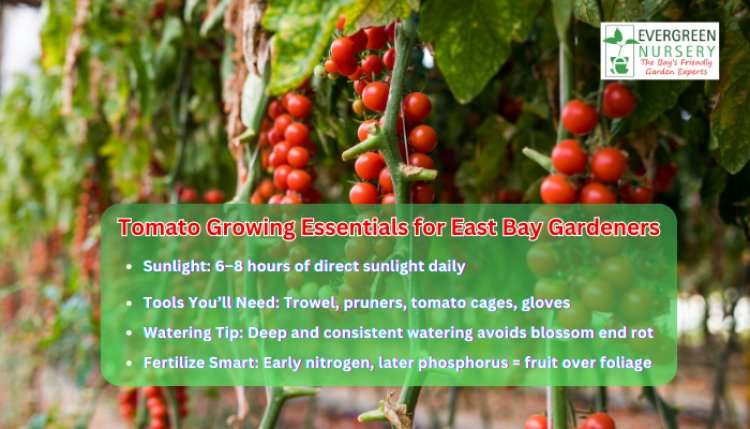Ten Tips For Growing Tomatoes in the East Bay
Share this Post to earn Money ( Upto ₹100 per 1000 Views )

Introduction:
Tomatoes are a favorite among home gardeners, especially in the East Bay where the Mediterranean climate offers warm, dry summers and mild, wet winters. However, growing the perfect tomato crop takes a little knowledge, the right tools, and consistent care. Whether you’re a seasoned green thumb or a first-time gardener, these ten tips will help ensure your tomato plants thrive in the unique conditions of the East Bay.
1. Choose the Right Tomato Varieties
East Bay gardeners should select tomato varieties that flourish in warm weather but can also handle some cooler evening temperatures. Opt for early maturing varieties like 'Early Girl', 'Stupice', or 'Celebrity'. These cultivars tend to perform well in microclimates and offer a higher yield before the late summer heat takes over.
2. Start with Healthy Soil
Tomatoes are heavy feeders, so starting with nutrient-rich soil is key. Amend your garden bed with well-rotted compost or organic matter to boost fertility. The ideal soil pH for tomatoes is between 6.2 and 6.8. Conduct a soil test to check pH and nutrient levels. You can adjust the soil accordingly with organic fertilizers or lime.
3. Pick a Sunny Location
Tomatoes love the sun. Ensure your tomato bed gets at least 6-8 hours of direct sunlight daily. East Bay gardeners should also be aware of coastal fog and shade from nearby buildings or trees. Select the sunniest spot in your garden to encourage fruit production.
4. Use the Right Gardening Tools
Investing in quality gardening tools will make the process smoother and more efficient. Basic tools like a hand trowel, pruners, gloves, and a watering can are essential. A sturdy tomato cage or trellis system will also support your plants as they grow and bear fruit. Having the right tools can mean the difference between a frustrating experience and a flourishing garden.
5. Water Consistently and Deeply
Inconsistent watering can lead to issues like blossom end rot and cracked fruit. Water deeply and regularly to keep soil consistently moist but not soggy. In the East Bay, where the climate can be dry in the summer, consider using a drip irrigation system or soaker hoses to conserve water and reduce evaporation.
6. Mulch to Conserve Moisture and Prevent Weeds
Mulching around your tomato plants helps retain moisture, suppress weeds, and regulate soil temperature. Organic mulches like straw, shredded leaves, or bark are great options. Apply a 2-3 inch layer around the base of each plant, leaving a small gap around the stem to prevent rot.
7. Prune for Better Air Circulation
Pruning your tomato plants helps improve airflow and reduce the risk of disease. Remove the lower leaves that touch the ground and any "suckers" that develop in the joint between the stem and a branch. This practice focuses the plant's energy on fruit production rather than excess foliage.
8. Fertilize Appropriately
Tomatoes benefit from a balanced fertilizer that includes nitrogen, phosphorus, and potassium. Start with a nitrogen-rich fertilizer to promote leafy growth in the early stages. As the plant begins to flower, switch to a phosphorus-heavy fertilizer to encourage fruiting. Be cautious not to over-fertilize, as it can lead to lush foliage but few tomatoes.
9. Watch for Pests and Diseases
Common tomato pests in the East Bay include aphids, whiteflies, and hornworms. Fungal diseases like early blight and powdery mildew can also be an issue due to morning fog and humidity. Regularly inspect your plants and use organic pest control methods when necessary. Neem oil, insecticidal soap, and introducing beneficial insects like ladybugs can help keep problems in check.
10. Harvest at the Right Time
The best time to harvest tomatoes is when they are fully colored and slightly soft to the touch. Picking tomatoes at peak ripeness ensures the best flavor and texture. In the East Bay, tomatoes typically ripen from late June through September, depending on the variety and weather conditions.
Before You Plant: Plan Your Space and Supplies
Before planting, take time to plan your garden layout and gather necessary supplies. Raised beds or large containers can be great options if you're working with limited space. Also, ensure you have all the essential gardening tools on hand so you're ready to hit the ground running. For a complete overview of tomato growing practices, you can explore the Wikipedia article on Tomato cultivation to deepen your knowledge and gain more perspective on the science behind it.
Final Thought
Tomatoes are a rewarding crop for East Bay gardeners, offering fresh, delicious fruit straight from your own backyard. With the right preparation, tools, and techniques, your tomato plants can produce bountiful harvests season after season. Whether you're growing cherry tomatoes on a balcony or heirlooms in raised beds, a little effort goes a long way. For expert advice, premium-quality gardening supplies, and healthy plants, visit The Evergreen Nursery and let your tomato-growing journey flourish!
#EastBayGardening #TomatoGrowingTips #HomeGardenGuide #GardeningInCalifornia













